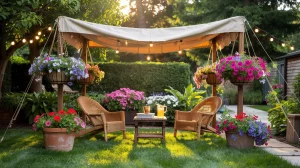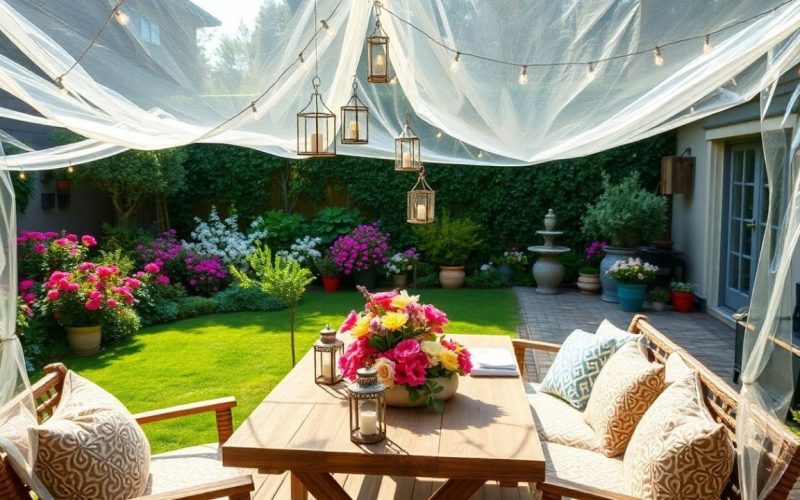Introduction
Tarpaulin, commonly known as tarps, is a versatile and durable material used in a variety of ways in both home and garden settings. Whether you’re looking for a protective cover for outdoor furniture, a weather-resistant shield for plants, or a DIY project to enhance your space, tarps can be an incredibly useful tool. But with so many different applications, you might wonder just how to best utilize this humble material. In this article, we’ll explore creative and practical ways to use tarpaulin in your home and garden, helping you protect your belongings and enhance your outdoor space.
What is Tarpaulin?
Tarpaulin is a large sheet of strong, flexible material made from woven fabric, often coated with polyethylene or PVC for added water resistance and durability. It comes in a variety of sizes, colors, and thicknesses, making it suitable for numerous tasks. Because of its waterproof nature, it’s often used in outdoor settings, but it can also be incredibly helpful inside the home. Tarps are commonly used to cover things, protect surfaces, and as a base for various projects, making them a must-have for homeowners and gardeners alike.
How to Use Tarpaulin In Your Home and Garden

1. Protect Your Outdoor Furniture
One of the most common uses of tarpaulin is protecting outdoor furniture from the elements. Whether you have expensive patio chairs, a wooden table, or cushions, tarps can shield them from rain, snow, and sun damage. By draping a tarp over your furniture, you can ensure they last longer and retain their appearance.
When using a tarp to cover outdoor furniture:
- Choose a heavy-duty, waterproof tarp to keep water from seeping through.
- Make sure the tarp is large enough to cover the entire furniture piece without exposing any parts to the elements.
- Secure the tarp with ropes, bungee cords, or even weights to prevent it from blowing away in strong winds.
This simple step can help protect your garden furniture and keep it looking new year after year.
2. Shelter for Plants and Vegetables
For gardeners, tarpaulin can be a lifesaver when it comes to protecting plants from harsh weather. During unexpected storms, frost, or high winds, tarps can create a protective cover to shield delicate plants and vegetables.
To use tarps for gardening:
- Drape tarpaulin over plants during a frost or freeze to keep them warm and insulated.
- Use tarps to protect vegetables from excessive rain that could damage leaves or cause fungal growth.
- You can even create makeshift greenhouses by draping a tarp over a framework of PVC pipes or wooden stakes.
For optimal use, ensure that the tarp is not in direct contact with the plants. Create a small frame to allow space for air circulation and prevent the tarp from crushing tender leaves.
3. Create a Temporary Canopy or Shade Structure
If you’re hosting an outdoor event or need extra shade in your garden, tarpaulin can be used to create a temporary canopy or shade structure. This is an affordable and easy way to provide shade from the sun or protection from light rain during a family BBQ or garden party.
To create a canopy with tarps:
- Choose a large, sturdy tarp and secure it between two or more stable supports (trees, posts, or poles).
- Make sure the tarp is pitched at an angle to allow rainwater to drain off rather than pool in the middle.
- Use bungee cords or strong ropes to secure the tarp and adjust its tension to keep it taut.
This method can easily cover a picnic table, outdoor seating area, or small outdoor kitchen. It’s an excellent solution for temporary shade when you’re entertaining outdoors.
4. DIY Flooring for Outdoor Events
Tarpaulin can also be used as a temporary floor cover for outdoor events like camping trips, picnics, or backyard gatherings. By laying down a tarp, you can create a clean, dry surface for seating, dining, or even dancing! It’s a great alternative to grass or dirt, especially when the weather is unpredictable.
When using a tarp for outdoor flooring:
- Choose a heavy-duty tarp that is large enough to cover the area you want to protect.
- Ensure the ground is clear of sharp objects like rocks or sticks that could puncture the tarp.
- Lay the tarp flat and secure it at the edges with weights or stakes to keep it from shifting.
This can also be helpful if you’re working on a DIY project in the garden and want to protect the ground from spills, stains, or dirt.
5. DIY Projects and Crafts
Tarps are also a fantastic material for various DIY projects around the house. You can use tarpaulin for crafting, sewing, and making home decor items. Whether it’s creating custom outdoor cushions, tote bags, or even repairing old furniture, the possibilities are endless.
Here are some creative DIY uses:
- Outdoor Cushions: Use tarpaulin to make water-resistant cushions for garden furniture or picnic areas.
- Tote Bags: Tarpaulin is tough enough to make durable, waterproof bags for shopping, gardening tools, or beach trips.
- Repair Projects: Patch up old garden chairs, tents, or tarps with tarpaulin for an easy and cost-effective fix.
Tarps come in various colors, so you can even choose a color that matches your outdoor aesthetic or personal style.
6. Covering Firewood or Outdoor Supplies
If you store firewood, garden tools, or other outdoor supplies, tarpaulin can help keep them dry and protected. A tarp can be draped over firewood stacks, tool sheds, or garden equipment to prevent water damage and mildew buildup.
To use tarps for covering supplies:
- For firewood, stack the wood neatly and cover it with a tarp that is slightly larger than the pile. Secure the tarp with ropes or weights to keep it in place.
- For garden tools or equipment, ensure the tarp covers the items completely, with no gaps where rain could get through.
This simple step can help keep your outdoor supplies in good condition, making them last longer and stay functional.
7. Create a DIY Shelter or Storage Space
If you need extra storage space in your garden or backyard, tarps can be used to create a simple, temporary shelter. This can be especially useful if you’re working on a home renovation project or need a dry area to store seasonal items like bikes, lawn mowers, or tools.
To create a tarp shelter:
- Set up a basic frame with poles or a wooden structure.
- Drape the tarp over the frame, securing the edges tightly.
- Ensure the tarp is anchored properly so it doesn’t blow away in the wind.
This type of shelter can be a practical and affordable storage solution, especially during the off-season or when you’re in between more permanent storage options.
8. Protect Your Car or Boat
If you don’t have a garage, a tarp can serve as a temporary cover to protect your car, boat, or RV from the elements. A tarp can shield your vehicle from dirt, dust, bird droppings, or sun damage, especially when you’re not using it for a while.
For protecting vehicles with a tarp:
- Choose a large, weather-resistant tarp that is designed for outdoor use.
- Secure the tarp tightly around the vehicle using ropes or bungee cords to prevent it from blowing away.
- Make sure the tarp doesn’t touch the vehicle directly to avoid scratching the paint.
This is an affordable solution for protecting your vehicle when a garage or carport isn’t available.
Conclusion
Tarpaulin is a simple, yet incredibly versatile material that can be used in countless ways around your home and garden. From protecting your outdoor furniture and plants to creating shade or flooring for outdoor events, tarps provide practical solutions that are both effective and affordable. Whether you’re using tarpaulin for DIY projects, shelter, or covering your car, its durability and water resistance make it a go-to choice for homeowners and gardeners alike. With a little creativity, you can find many ways to incorporate tarpaulin into your home and garden, making it a valuable tool for everyday use.










